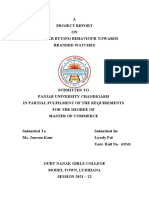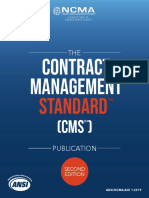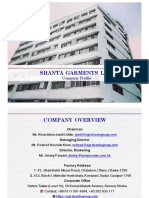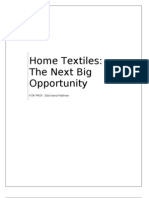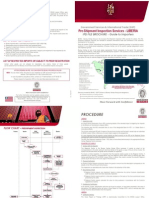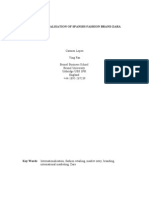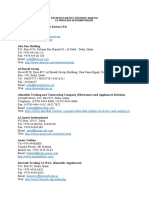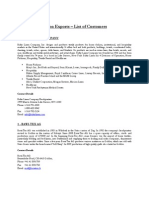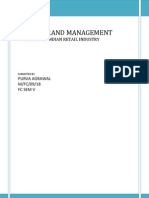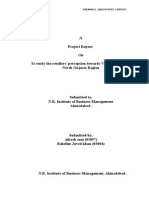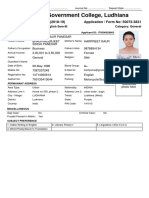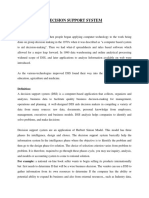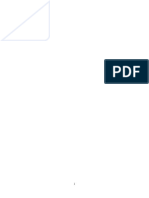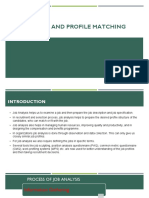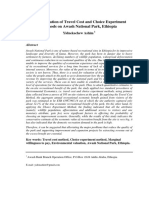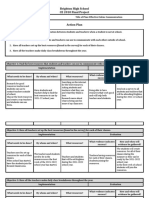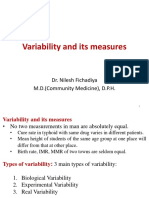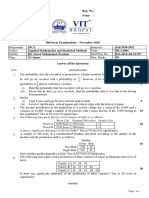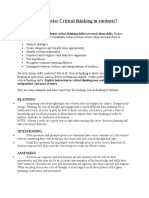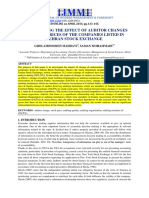CRM of Indira Hosiery
Uploaded by
Singh GurpreetCRM of Indira Hosiery
Uploaded by
Singh GurpreetA
PROJECT REPORT
ON
CUSTOMER RELATIONSHIP MARKETING PRACTICES
FOLLOWED BY INDRA HOSIERY MILLS
SUBMITTED TO
PANJAB UNIVERSITY, CHANDIGARH,
In the partial fulfillment of the requirements for the award of
Degree of
MASTERS OF COMMERCE
Supervised By Submitted By
Mrs. Punpreet Kaur Varonica Jindal
Assistant Professor in Commerce Deptt. M.Com 2nd Sem
Univ. Roll No.
SESSION 2020-22
Department of Management
GURU NANAK KHALSA COLLEGE FOR WOMEN,
MODEL TOWN, LUDHIANA
ACKNOWLEDGEMENT
I owe the success of completion of this project to many minds whose continuous support
and encouragement helped me in finishing this project.
First and foremost Iam indebted to company director Mr. Kamal Jain for his guidance in
course of my study.
I express my deep feeling of gratitude and profound respect and indebtness to Mrs.
Punpreet Kaur (Assistant Professor) for guiding me in making this project and
providing me with valuable knowledge.
I take this opportunity to thank all staff members of Indra Hosiery Mills who spared their
precious time to provide me with valuable inputs for project without which it would not
have been possible.
All names may not be mentioned but no one is forgotten; so thanks to all. All errors and
shortcomings are mine.
INDEX
CHAPTER NO. CHAPTER NAME PAGE NO.
Chapter 1 Introduction 1 - 10
Chapter 2 Review of Literature 11 – 12
Chapter 3 Research Methodology 13 – 17
Chapter 4 Data Analysis & Interpretation 18 – 31
Chapter 5 Findings, Suggestions & Conclusion 32 – 34
Bibliography 35
Annexure 36 – 38
CHAPTER – 1
INTRODUCTION
1.1 CONCEPT OF CUSTOMER RELATIONSHIP MANAGEMENT
Customer Relationship Management (CRM) is a well-known business concept.
Managers today are working hard to build and maintain a relationship with the customer -
given the importance of customer lifetime value. While the concepts of CRM
andCustomer Lifetime value are well established and understood by managers,
managing customer relationships has become a challenge for many managers. Several
firms have implemented dedicated software tools for customer relationship management,
and even more number of companies is planning to do the same. Few firms have even
created offices of customer relationship management: Client partners, Account managers,
Program Managers etc. In spite of all these efforts, managers are finding it hard to
manage customer relationships.
The challenge of managing customer relationships led to a new conceptcalled Levels of
Customer Relationships developed by INSEAD, France. The central theme of this
concept is:
Customer relationship is an evolutionary process that can be identified as 6 distinct
stages.
Customers have different needs and expectations during different stages of this
relationship.
Customer relationship is a dynamic process and can move from one stage to another
based on customer's aspirations and customer's buying experience
1.2 CUSTOMERS HAVE A RELATIONSHIP WITH THE VENDOR
Every salesman knows that customer often wishes to have a relationship with the vendor.
Many firms therefore want to make use of this relationship and have instituted customer
loyalty programs - aimed at rewarding loyal customers. For example, Airlines have free
miles program, credit card firms have points program, Grocery stores have a special
discount for loyalty cardholders etc.
1
Looking from the customer's perspective, customer expresses a need for a relationship
with the vendor for a few basic reasons: satisfy their needs, convenience, reliability, and
lower cost of transaction. Customers need products or services and will obtain them, but
they are willing to enter into a relationship with the seller to make the process of buying
easier and a more pleasant experience.
One has to note that the intensity or depth of the relationship, which the customer
expresses to have with the vendor, depends in the intensity of his/her needs. If a
product/service is vital to the customer e.g. financial product, then customer is willing to
have a deeper relationship in order to have their needs satisfied as precisely as possible.
On the other hand if the customer wants a routine service or generic product e.g.
customer needs tips from his broker while trading in the stock market, then the
relationship is superficial - characterized by buyer's convenience. To understand this
considers the following examples:
1. Customer, who is a telecom service provider, wants to implement ERP software. Since
the software has to be customized for the Telco, the customer is willing to establish a
2. deep relationship with the vendor by having a development & maintenance contract with
the vendor.
3. Customer, who wants a copy of MS Project installed in a computer. Since this is a
simple purchase, the customer wants to buy it from a nearby store and install it himself.
Thus there is no real relationship between the customer and the vendor.
Both examples point to the fact that the level of relationship a vendor enjoys with the
customer is directly dependent on the criticality or importance of customer's needs. In
short, customers enter into a relationship with the vendor in order to serve their own
needs.
1.3 STRENGTHENING CUSTOMER RELATIONSHIPS
We now understand that the depth of the relationship between vendor and customer is
directly dependent on the intensity of the customer's needs. Also note that the customer
defines the depth of relationship. This creates a challenge for a salesman or a marketer at
the vendor firm. For a vendor to iNcrease sales, the vendor firm must improve the
2
relationship with the buyer. And to improve the relationship, vendor must know the
current level/stage of relationship he has with the customer. So the first step in managing
customer relationship is to know and understand the levels of customer relationships.
1.4 RELATIONSHIP MARKETING
Relationship Marketing has an aim of building mutually satisfying long term relationship
with its clients in order to earn and retain their business. Marketer accomplishes this by
promising and delivering high quality product and services at fair price to the other
parties over time. Relationship marketing build long& strong economical, technical and
social ties among the parties. The ultimate outcome of relationship marketing is the
building of unique company assets called the marketing network.
A Marketing network consists of the company and its supporting stakeholders (Clients,
Employees, ad agencies and others) with whom it has built mutually profitable business
relationship. The operating principal is to build an effective network of relationship with
key stakeholders.
Marketing Channel: To reach target market, marketer uses three kinds of marketing
Channel.
1. Communication Channel: It delivers & receives messages from target buyers and
includes newspaper, television, telephone etc.
2. Distribution Channel: To display sell or deliver the physical product or service(s) to the
buyer or user. This includes distributors and agents.
3. Service Channel: To carry out transaction with potential buyers. Marketer clearly faces a
design problem in choosing the best mix of communication, distribution and service
channel for their offerings
Supply Chain: The marketing channel connect the marketer to the target buyers, the
supply chain describe a longer channel stretching. The supply chain represents a value
delivery system. Each company captures only a certain percentage of total value
generated by the supply chain. When a company acquires competitor or moves upstream
of downstream, its aim is to capture a high percentage of supply chain value.
3
Competitor: It includes all the actual and potential rival offering and substitutes that a
buyer might consider. We can broaden the picture further by distinguishing four levels of
competition based on the degree of product sustainability:
1. Brand Competition: A company sees its competition as other companies offering
similar products and service to the same customer at similar price.
2. Industry Competition: A company sees its competition as all company making the same
products or class of products
3. From Competition: A company sees its competitors as all companies manufacturing
products that supply the same service.
4. Generic Competition: A company sees its competitors as all companies that compete for
the same consumer.
Marketing Environment: Competitor represents only one force in the environment in
which the marketer operates. The marketing environment consists of the task
environment and the broad environment.
1. Task environment: It includes immediate actors involved in producing, distribution and
promoting the offering. The main actors are the company, suppliers, distributing, retailers
and the target customer.
2. Broad environment: It consists of demographic environment, economical environment,
natural environment, technological environment, political environment, and socio-
cultural environment. These environments contain forces that can have a major impact in
task environment.
1.5 BRIEF PROFILE OF INDRA HOSIERY MILLS
Manufacturer
Wholesaler
Nature of Business
Retailer
Buyer-Company
Ownership & Capital
Year of Establishment 1954
Ownership Type Sole Proprietorship (Individual)
4
Trade & Market
Annual Turnover Rs. 5 crore – 10 Crore
Team & Staff
Total Number of Employees 101 to 200 People Approx.
No. of Research / QC Staff 1 - 5 People
No. of Engineers & Technicians 6 - 25 People
No. of Skilled Staff 46 - 65 People
No. of Semi-Skilled Staff 1 - 5 People
Packaging/Payment and Shipment Details
Cash Cheque
Payment
Wire
Mode DD
Transfer
Shipment Mode By Road
Today The Group – ‘INDRA HOSIERY MILLS’ largest Jacket manufacturers in India,
beholds the strong presence in fashion and garments industry, not only in India but
worldwide too. The Group has experienced the progressive path with too many
achievements made in last 58 years since its inception way back in 1954. The Group with
an immense notion across the industry verticals is iconified for being the trend-setter in
the field to Jackets and Coats caprices. Being sensitive to the market-needs and the
changing fashion trends the Group manufactures trendy and highly fashionable garments
that set it apart from the other manufactures.
With roots that date back to half a century this is a Group in the Garments Industry
standing on the grounds of fashion and innovation. The Group has made a massive
impression across the industry verticals by trend-setting in the field to Jackets and Coats
caprices. Being sensitive to the market-needs and the changing fashion trends the Group
manufactures trendy and highly fashionable garments that set it apart from the other
manufactures.
5
1.5.1 VISION OF THE FOUNDER
The Group came into existence in 1954 under the leadership of Late Shri Tribhawan Lal
Jain with a vision to create a manufacturing set up for Jackets, at the time when Jacket as
a fashionable product, practically had no standing in India. The IHM Group that today
enjoys the leadership, bestows it’s founder Late Shri Tribhawan Lal Jain for his vision of
Jacket manufacturing 58 years back which today has potential of 20 to 25% annual
growth!
1.5.2 EXCELLENCE IN DESIGNS AND STITCHING
As and epitome of elegance and sophistication, the Group's exemplary designs together
with unbeatable quality put it at the pinnacle of fashion glory. Striking Colour -
Combinations together with perfect tailoring, gives the Group's garments an outstanding
look and overwhelming customer-response.
1.5.3 JACKETS-THE GARMENTS IN FASHION
The Group renowned for its launch product ‘The Jackets that Indra Hosiery Mills (IHM)
started manufacturing in 1954’ is today’s most hot and potential oriented product in
fashion trends with growth expected 20 to 25% annually.
1.5.4 DESIGNS
Each year, more than 1000 new designs embellished with pageantry and beautiful looks
and styles of Jackets for men and women are visualized and created by team of highly
skilled designers. The integration of trend-setting designs and styles and attractive eye-
catching colors, together make IHM,s Jackets look apart from other brands. Every season
IHM has plenty to cater to various segments of the society.
1.5.5 PRODUCT PORTFOLIO
Indra Hosiery Mills is one of the renowned manufacturers, suppliers and exporters of
Jackets and Garments. The products manufactured by us are made of superior grade yarn,
6
and are extremely comfortable, easy to wash and exclusive. We use only high quality
wool and yarn in the production process to manufacture premium products.
Indra Hosiery mills range includes the following apparels:
Jackets
Sweatshirts
Tops
Coats
Designer Kurtis
Middi
Legging
Capri &Pazzams
Woolen Cardigans
Woolen Innerwear
Bermuda
T-shirts
The products are manufactured using imported German
CMS Stoll Machines to bring forth an innovative and
formidable range. Our products are hugely demanded
amongst the customers owing to certain reasons which are
mentioned below:
Reliability
Vibrant Colors
Colorfastness
Durable Stitching
Elegant Designs
Interesting Patterns
Soft Fabric
Easy to Wash
Trendy
Cost Effective Rates
7
1.5.6 INDRA HOSEIRY TEAM
Indra Hosiery’s Team is the backbone of the organization and it works relentlessly to
offer stupendous quality products to the customers. The team comprises competent and
highly qualified personnel possessing ample experience in this field. We have specialized
teams for different departments, these are mentioned below:
Procurement Agents
Technicians
Quality Analyst
Sales and Marketing Personnel
Indra Hosiery’s team members are acquainted with cutting edge technology and are
aware of the client's needs. Procuring agents procure raw material from reputable vendors
and the quality controllers conduct stringent tests at all stages of the production. The team
of skilled and creative craftsmen proficiently design and bring forth an exclusive range of
apparels. Further, owing to our adept sales and marketing personnel, we are able to
successfully cater to the needs of the customers.
1.5.7 ORGANIZATIONAL CHART
MANAGING DIRECTOR
CHIEF EXECUTIVE OFFICER
AREA GENERAL MANAGER
AREA MANAGER
ASSISTANT SHIFT MANAGER
SHIFT MANAGER
8
1.5.8 FUNCTIONAL DEPARTMENTS OF THE ORGANISATION
Production Department
Production is the bias activity of all industrial units. All the other activities revolve round
this activity.The end product of production activity is the certain of goods and services
for the satisfaction of human wants. According to economics, product is an activity
through which the form utility is either created or enhanced. Indra Hosiery Mills owns
and operates many manufacturing plans. It also sources from hundreds many other
authorized factories in order to always give customers the right garments at the right
price.
Research & Development Department-
Mumbai factory has its own in house R&D department. They instruct the control of input
of raw material and in the process quality control and checking of finished goods.Various
tests on improvements to the product, product addition or deletion are conducted. In
R&D department the importance is given to finest quality garments. From the sales
department they get the information about the market i.e., feedback.Associates do all
material requirements. R&D department gives the quality specification.
Personnal department:
Everybody knows that an organisation achieves its ends by a proper utilization of the
monetary, material and human resources at its command. While and human resource that
all the other resources are mobilized and utilized to achieve organisational objectives.
This human resource is the most important of the resources, without it, an organisation
cannot accomplish its objectives.The number, variety and complexity of the functions of
personnel management raise a question that who should discharge the functions of the
personnel department in an industrial establishment. To begin with, every manager and
every supervisor. To begin with, every manager and every supervisor discharges some of
these functions; for example, the motivation of employees to greater output and
efficiency. Some managers and supervisors are involved in the selection, appointment
and promotion of personnel and in disciplining formal employees. However, by and
large, there is one person who discharges the main function and co-ordinates certain
personnel functions discharged by various other managers and supervisors.
9
1.5.9 MARKETING
Jackets for men and women manufactured by IHM are available throughout India. IHM
has plenty for every strata of society. Its over 500 clients' profile includes Institutions,
leading Retail Chain Stores, Departmental Stores, Wholesalers as well as Retailers.
1.5.10 FUTURE PLANS
IHM endeavors to continue to remain at the top in the field of designing and manufacture
of Jackets by introducing latest concepts fabrics
10
CHAPTER – 2
REVIEW OF LITERATURE
Al-Shammari and AlShowaikh (2021) examined users' satisfaction with a customer
relationship system (CRM) system in Bahrain. The selected variables are perceived ease of
use, perceived usefulness, user support, facilitating conditions, and social influence. A
sample of seventy employees working in a telecommunications company was selected to
answer the questionnaire, but sixty questionnaires were retrieved. The collected data were
analyzed using the partial least square–structural equation modeling (PLS-SEM) approach.
The SmatPLS 3.3.3 software was used to perform data analysis. The results revealed that
employees were highly satisfied with the CRM system and a significant relationship between
the selected variables and user satisfaction. CRM has become a crucial system for
organisations, given that customers are the number one factor in delivering economic value
for companies.
Sakuntala (2021) identified and seek the opinion of the marketing and technical people
in service and manufacturing organizations with regard to perceived benefits of CRM
which are the promises of software package before implementation are realized through
the implementation of CRM in both service and manufacturing industries.
Mathiraman and Kumar (2017) examined the various facts of CRM (Customer
Relationship Management practices adopted by Manatec in Puducherry. This study
examined the demographic profile of customers, customer awareness of CRM policies,
customer perception on CRM practices, factors influencing CRM practices and role of E-
CRM measures of Manatec in customer satisfaction. This study utilized 52 samples in
various parts of Puducherry. The data for the study have been collected through a
questionnaire. This study revealed that the customer relationship management practices
followed in Manatec are satisfactory to the customers.
Hassan et al., (2015) evaluated the effectiveness of customer relationship management
(CRM) in retaining and satisfying customers with reference to Shell Pakistan. This study
11
shows that customer relationship management has significant effect on the customer
satisfaction and both variables have positive relation. Company makes its CRM as strong
and reliable the customer will be more satisfied and retain with the company. The study
concluded that CRM is playing a major role in increasing the market share, it enhances
productivity, superior employee's morale in the mean while it improves the in depth
customer knowledge and also higher customer satisfaction to improved customer loyalty
company will also have the clear information that what are their customers, what are their
needs, and what will make them more satisfied.
12
CHAPTER – 3
RESEARCH METHODOLOGY
3.1 NEED OF STUDY
Today, for any organization or firm to survive in this competitive world depends on its
ability to be dynamic and be different from the competition to be unique in the industry.
Customer Satisfaction helps every organization to keep the existing customer and to build
new customer. The purpose of this study is to study whether Customer relationship
management policies followed by Indra Hosiery Mills cater to the needs of the clients or
not. Whether the clients are happy with the services provided by Indra Hosiery Mills.
3.2 OBJECTIVES OF THE STUDY
To study the customer relationship marketing practices that is implemented at customer
level in Indra Hosiery Mills.
To study the effect of customer relationship marketing practices while making purchase
and repurchase decision
To find the reasons why Indra Hosiery Mills should follow the CRM practices.
To know the satisfaction level of retailers towards Indra Hosiery Mills.
3.3 SCOPE OF THE PROJECT
This research was conducted in region on 30 respondents who have been purchase
products through Indra Hosiery Mills.
3.4 MEANING OF RESEARCH
Research is a systematic method of finding solutions to problems.Research simply means
a search for knowledge. Research is an original contribution to the existing stock of
knowledge making for its advancement. It aims at discovering the truth. Research is a
process of systematic and in-depth study or search of any particular topic, subject or area
of investigation backed by collection, computation, presentation and interpretation of
relevant data.
13
3.5 MEANING OF METHODOLOGY
Methodology means methods of conducting research and the logic behind the methods.
The methodology is the theory of how research should be undertaken. It is the tools and
techniques used to obtain and analyze data.
3.6 MEANING OF RESEARCH METHODOLOGY
Research methodology means the method adopted in studying the problem. It helps in
explaining the tools and techniques used in studying the problem under study. It is
necessary that the researcher should know which tool is used and for what purpose.
Research methodology is a way to systematically show the research problem. The
research methodology not only talk about the research methods but also consider the
logic behind the method we sue in the context of our research study and explain why we
are using others so that the research results are capable of being evaluated either by the
researcher himself or by others.
3.7 RESEARCH DESIGN
Research design is the “framework or blueprint” for collecting information needed in the
best possible way. The correct design will save resources and also tests the validity and
the reliability of the research.
A research design is the arrangement of conditions for collection and analysis of data in a
manner that aims to combine relevance of the research purpose with economy in
procedure. It constitutes the blueprint for the collection, measurement and analysis of
data. The design includes an outline of what the researcher will do from writing the
hypothesis and its operational implication to the final analysis of data. The decision with
respect to the following will be included in the research design.
3.8 DESCRIPTIVE RESEARCH
In this study descriptive type of research is adopted. This type of research includes
surveys and fact-finding enquiries of different kinds. These major purpose of descriptive
research is description of the state of affairs as it exists as present. The main characteristic
14
of this method is that the researcher has no control over the variables; he can only report
what has happened or what is happening.
3.9 METHODS OF DATA COLLECTION
The search for answers to research questions calls for collection of data. Data are facts,
figures and other relevant materials, past, and present, serving as bases for study and
analysis.
3.9.1 Primary Data:
Primary data is collected with the help of interview techniques, question naire and
consumer survey methods. Interview is an effective, informal verbal and non verbal
conversation, initiated for specific purpose and focused on certain planned content
areas. Questionnaire is a systematic compilation of questions that are submitted to a
sampling of population from which information is desired. Consumer surveys are
conducted to learn what consumers think of promotion how many took advantage
of it and how the promotion affected subsequent brand-choice behavior.
3.9.2 Secondary Data:
Secondary data are those which have already been collected by someone else and which
have already been passed through the stratified process. It has collected through the
books, journals, and Internet.
3.10 SAMPLING TECHNIQUES
The sampling method adopted is the non-probability sampling method. In non-probability
sampling method the convenience sampling method is used here. In convenience
sampling method the researcher can collect the samples as per his or her convenience.
This is usually adopted when the population is unknown and the area of study is very
wide.
3.10.1 Population Size:-
Population Size of this project is unknown.
15
3.10.2 Sample Size: -
It is the number of items that has been selected from a population to make the study.
Sample size of 30 samples was considered for this study
3.10.3 Area of the study: - The study has been conducted only on the Ludhiana district.
3.11 SAMPLING METHODS
The sampling method adopted is the non-probability sampling method. In non-probability
sampling method the convenience sampling method is used here. In convenience
sampling method the researcher can collect the samples as per his or her convenience.
This is usually adopted when the population is unknown and the area of study is very
wide.
3.12 TOOLS USED FOR DATA ANALYSIS
The collected data were analyzed with the help of simple percentage analysis.
Percentage Analysis
Percentage refers to a special kind of ratio in making comparison between two or more
data and to describe relationships. Percentage can also be used to compare the relation
terms the distribution of two or more sources data.
Number of Respondents
Percentage of Respondent = ×100
Total Respondent
16
CHAPTER – 4
DATA ANALYSIS & INTERPRETATION
Q1. For how many years have you been trading with Indra Hosiery Mills?
Table: 1 Time period of Experience with Indra Hosiery Mills
S.No Time(years) Respondents Percentage
1 <1 2 6.66
2 1 to 2 4 13.37
3 2 to 4 14 46.66
4 4 to 5 10 33.37
Total 30 100
13.6
13.37
13.4
13.2
13
12.8
12.6
12.37
12.4
12.2
12
11.8
24 6 30
Figure: 1 Time period of Experience with Indra Hosiery Mills
INTERPRETATION
From the graph it can be easily concluded that 46.66 percent respondents have been 2 to
4 years. This is a maximum % among respondents. Next in line are respondents who have
been Indra Hosiery Mills since 4 t o 5 years. They are 10 in number. 13.37 percent
respondents have been experience in Indra Hosiery Mills for 1-2 years and 6.66 percent
have been Indra Hosiery Mills since less than one year. The data clearly depicts that most
people have been Indra Hosiery Mills from 2 to 4 years. This is more them enough time
to judge the company. This means that the clients are happy with the policies of this
particular firm and services provide by them. This is the reason why they have been with
the company for a considerable time.
17
Q2. Are you aware of the customer relationship marketing policies followed by the
company?
Table 2 Awareness of Customer relationship marketing policies
S.No Options Respondents Percentage
1 Yes 24 80
2 No 6 20
Total 30 100
20
Yes
No
80
Figure 2 Awareness of Customer relationship marketing policies
INTERPRETATION
From the pie chart depicted above it is clearly understood that out of 30 respondents 20
are aware of the Customer relationship marketing Practices followed by Indra Hosiery
Mills and rest 10 are not aware.
This is pretty much straight forward question as majority of respondents are aware of the
CRM practices followed. The reason may be that they are aware of the term themselves
then the rest.
18
Q3. What are the Customer Relationship marketing practices followed by the
company?
Table 3 Customer Relationship marketing Policies
S.No Practices Respondents Percentage
1 Optimum solutions 3 10.00%
2 Updated Information 15 50.00%
3 Long term concessions 0 0.00%
4 Door Step services 2 6.66%
5 Regular in touch 8 26.66%
6 Any other 2 6.67%
Total 30 100
60.00%
50.00%
50.00%
40.00%
30.00% 26.66%
20.00%
10.00% 6.66% 6.67%
10.00%
0.00%
0.00%
s on ns ice
s
uc
h
he
r
on ati sio v to t
lu
ti
rm ce
s se
r
in yo
so fo co
n ep lar An
um In St
ed rm r gu
tim at te o Re
Op d g Do
Up Lo
n
Figure 3 Customer Relationship marketing Policies
INTERPRETATION
By studying the chart above we can conclude that out of 30 respondents, half percentage
thought the Customer Relationship Marketing Practice followed by the company is
providing updated information of the new launched policies. Next in line are 10
respondents according to whom providing optimum solutions to the problems is the
major CRM practice. 26.66 percent respondents think that being regular in touch with
their RM’s is the practice followed while remaining were divided among door step
services, any other and long term concessions in the ratio of 2:2:1.
Most of the respondents responded that getting updated information is the best CRM
policy adopted by the company.
19
Q4. Choose any 3 from the mentioned practices which you think are important
from a company point of view?
Table 4 3 choose 3 Customer relationship Practices
S.No Practices Respondents Percentage
1 Optimum solutions 3 10.00%
2 Updated Information 13 43.34%
3 Long term concessions 2 6.66%
4 Door Step services 4 13.33%
5 Regular in touch 7 23.33%
6 Any other 1 3.34%
Total 30 100
50.00%
45.00%
40.00%
35.00%
30.00%
25.00%
20.00%
15.00%
10.00%
5.00%
0.00%
ns on ns ice
s
uc
h er
tio ati sio r v to oth
lu r m es se in y
so fo nc p An
In co te lar
um ed
S gu
tim at rm or Re
p d g te Do
O Up n
Lo
Figure 4 chose 3 customer relationship Practices followed by company
INTERPRETATION
This question is for all the respondents that what according to them is a important policy
a company should follow. Here 13 respondent think that giving up to date information is
the key while 3 says providing optimum solutions is important. Keeping in touch with
your RM manager after buying is important for 7 respondents. 4 people opted for door
step services and 2 gave other reasons while 2 was for long term concessions.
20
Q5. Choose any reasons why Indra Hosiery Mills should follow the above mentioned
practices.
Table 5 Reason for Indra Hosiery Mills to follow these practices
S.No Practices Respondents Percentage
1 Building Brand image 3 10.00%
2 Competitors 2 6.66%
3 Retention of customers 15 50.00%
4 Increase in sales and profits 2 6.666%
5 Word of mouth 5 16.67%
6 Any other 3 10.00%
Total 30 100
60.00% 50.00%
40.00%
10.00% 16.67% 10.00%
20.00% 6.66% 6.67%
0.00%
Figure 5 Reason for Indra Hosiery Mills to follow these practices
INTERPRETATION
This bar chart gives us an idea about why Indra Hosiery Mills should follow above
mentioned practices. 15 of the respondents were in favor of retention of customers.
Second were those 3 respondents according to whom building brand image should be the
reason. 5 thought that by following above practices Indra Hosiery Mills can gain from
word of mouth. Rest of the respondents gave reasons like increase in sales and profits,
competitors and others in ratio of 4:3:2. More people stated that retention of customers
should be the main reason for a company because in such competitive world if a
customer is not satisfied from a particular firm he can easily move onto other company.
So it become necessary for a company to provide good services , schemes to retain the
customers.
21
6 (a). Satisfaction Level for Staff Efficiency
Table 6 (a) Satisfaction Level for Staff Efficiency
Staff Efficency
25
20
15
Respondents
10
0
Excellent Very good Good Average Poor
Satisfaction Level
Figure 6 (a) Satisfaction Level for Staff Efficiency
INTERPRETATION
The chart above gives us indication about the satisfaction level of respondents for staff
efficiency. Out of these 22 are happy with the efficiency of the staff. Rest of respondents
varies from 15 to 2.
The reason which can be given is that these respondents may have better relations with
their retailers and updates are provided to them instantly.
22
6 (b) Satisfaction Level for Redressing of complaints
Table 6 (b) Satisfaction Level for Redressing of complaints
16
14
12
10
espondents
8
6
R
4
2
0
Excellent Very good Good Average Poor
Satisfaction Level
Figure 6 (b) Satisfaction Level for Redressing of complaints
Interpretation
The above bar chart shows the number of respondents corresponding to redressing of
complaints. Here striking feature is that both the very good and average experiences
match each other.ie 14 each.
This is a tricky one as this satisfaction level varies considerably. Some complaints have
been addressed quickly and some not. It also depends on the nature of complaints.
23
6 (c) Satisfaction Level for Timely Responses
Table 6 (c) Satisfaction Level for Timely Responses
18
16
14
12
10
Respondents
8
6
4
2
0
Excellent Very good Good Average Poor
Satisfaction Level
Figure 6 (c) Satisfaction Level for Timely Responses
INTERPRETATION
The bar chart above gives us information about timely responses.16 respondents are
happy with the time at which they are given the responses.4 is the least figure.
More respondents are in favour of Good option as their experiences have been good in
getting responses. Comparatively the number is more inclined towards good, excellent
level and less towards poor.
24
Satisfaction Level for Updated information
Table 6 (d) Satisfaction Level for Updated information
14
12
10
Respondents
0
Excellent Very good Good Average Poor
Satisfaction Level
Figure 6 (d) Satisfaction Level for Updated information
INTERPRETATION
The above bar chart gives us information about satisfaction level for updated
information.13 percent are not satisfied while only 6 are extremely happy.
The reason is that some of these respondents even after getting information don’t trade so
automatically relationship managers become hesitant before telling next time.
25
6 (e) Satisfaction Level for Clarity of concept
Table 6 (e) Satisfaction Level for Clarity of concept
18
16
14
12
10
Respondents
8
6
4
2
0
Excellent Very good Good Average Poor
Satisfaction Level
Figure 6 (e) Satisfaction Level for Clarity of concept
INTERPRETATION
This bar chart gives us information about satisfaction level for clarity of concept.16
respondents say this service is excellent while 3 percent say average.
It can be concluded that people have clarity of concept regarding purchasing of Indra
Hosiery Mills products as some retailers don’t give full information initially with the fear.
26
Q7. Are these Customer Relationship marketing policies followed influential in
further purchasing?
Table 7 Influence of Customer Relationship Practices in further purchasing
S.No Options Respondents Percentage
1 Yes 18 60
2 No 12 40
Total 30 100
40
Yes
No
60
Figure 7 Influence of Customer Relationship Practices in further purchasing
INTERPRETATION
This pie chart shows the number of respondents who think whether these Customer
relationship policies are influential in further purchasing or not. After conducting the
survey 18 were in favor and 12 were not.
Most people responded in favor because according to them if policies and services are
good then they will be satisfied with the company and purchasing further.
27
Q8. Does the company conduct customer satisfaction survey?
Table 8 company conduct customer satisfaction survey.
S.No. Practices Respondents Percentage
1 Excellent 11 36.66%
2 Very good 9 30.00%
3 Good 6 20.00%
4 Average 3 10.00%
5 Poor 1 3.37%
Total 30 100
40.00% 36.66%
35.00%
30.00%
30.00%
25.00%
20.00%
20.00%
15.00%
10.00%
10.00%
5.00% 3.37%
0.00%
Excelent Very good Good Average Poor
INTERPRETATION
By studying the chart above we can conclude that out of 30 respondents. The satisfaction
level of 6 respondents is good and 9 respondents are very good. The satisfaction level of
11 respondents is excellent and 3 say is average and rest of them satisfaction level is
poor. More respondent are in favor of good option as their experiences have been good in
getting responses. Comparatively the number is more in client towards good, excellent
level and less towards poor.
28
Q9. Is there any need to improvement in customer retention and
loyalty?
Table 9 need to improvement in customer retention and loyalty
S.No. Improvement Respondent Percentage
1 Yes 18 60
2 No 12 40
Total 30 100
Improvement
40%
60%
Yes
No
INTERPRETATION
This pie chart gives us an idea about most number of respondents wants to improvement
in customer loyalty and retention.
29
Q10. Will you recommend Indra Hosiery Mills to others?
Table 10 Recommend to others
S.No Options Respondents Percentage
1 Yes 19 63.37%
2 No 11 36.66%
Total 30 100
36.66%
Yes
No
63.37%
Figure 8 Recommend to others
INTERPRETATION
The above pie chart gives us information about number of people who will recommend
Indra Hosiery Mills to others. 19 responded that they would suggest Indra Hosiery Mills
and 11 responded that they will not recommend.
The people who will recommend are those who are satisfied with Indra Hosiery Mills
services or in recent time have earned profits.
30
CHAPTER – 5
FINDINGS, SUGGESTIONS, LIMITATIONS &
CONCLUSION
5.1 FINDINGS
The clients are happy with the policies of this particular firm and services provide by
them. This is the reason why they have been with the company for a considerable time.
More people stated that retention of customers should be the main reason for a company
because in such competitive world if a customer is not satisfied from a particular firm he
can easily move onto other company. So it become necessary for a company to provide
good services, schemes to retain the customers.
The reason which can be given is that these respondents may have better relations with
their retailers and updates are provided to them instantly.
The reason is that some of these respondents even after getting information don’t trade so
automatically relationship managers become hesitant before telling next time.
Most people responded in favor because according to them if policies and services are
good then they will be satisfied with the company and purchasing further.
The factors which have an impact on the CRM are – organization culture, support from
top management, interpersonal skill of the sales personals and working environment of
the company.
5.2 SUGGESTIONS
Indra Hosiery Mills should enhance the customer care department where queries can be
timely solved.
Indra Hosiery Mills should provide more security to the existing and prospective clients.
There should be more banners posters pamphlets distribution in the market to increase the
awareness level among the people.
It should provide regular and update market information.
There should be target incentive for executive which will boost up their morale will give
more and more business to Indra Hosiery Mills.
31
Special attention need to be given to the delivery of monthly & fortnightly report to the
clients.
5.3 LIMITATIONS OF THE STUDY
The study based on survey through pre-designed questionnaires suffers from the basic
limitations of the possibility of difference between what is recorded and what is the truth,
no matter how carefully the questionnaire has been designed and field investigation has
been conducted.
The sample size was limited.
Time has played a biggest constraint that the research could not be carried out
comprehensively as the duration of the study was only 6 weeks
The customer may be biased.
Study is done only for Ludhiana customers.
As the project is also based on secondary data, possibility of unauthorized information
cannot be avoided.
As no work has been done earlier in this regard so scarcity of secondary data is also there.
5.4 CONCLUSION
Indra Hosiery Mills has emerged a very strong player in the field of garment products
within a short period in Ludhiana and is giving stiff competition to the entire player in the
Ludhiana& other parts of Punjab.
The clients are happy with the customer relation policies of Indra Hosiery Mills and
services provide by them. This is the reason why they have been with the company for a
considerable time. Retailers stated that retention of customers should be the main reason
for a company because in such competitive world if a customer is not satisfied from a
particular firm he can easily move onto other company. So it become necessary for a
company to provide good services, schemes to retain the customers. If the progress of
Indra Hosiery Mills goes in the same way then I can say that Indra Hosiery Mills will be
going to emerge as a major player in the motor drive products market. They have much
more potential to expand their business and market in India.
32
BIBLIOGRAPHY
Adireddy Sakunthala. Perceived benefits of CRM in selected Industries. Asian Journal of
Management. 2021; 12(2):151-6. doi: 10.52711/2321-5763.2021.00023 Available on:
https://ajmjournal.com/AbstractView.aspx?PID=2021-12-2-10
Al-Shammari and AlShowaikh, A.F (2021). Investigating user satisfaction of customer
relationship management in a telecommunications company in the kingdom of Bahrain.
International journal of ebusiness and egovernment studies, 97-116.
Berry, M. (1999). Data Mining Techniques. For Marketing Sales and Customer
Relationship Management.
Gupta C.B., Rajan N, Nair (2003), Marketing management, New Delhi Sultan Chand &
sons, publishers.
Gupta S.P., Statistical Methods, New Delhi, Sultan Chand & Sons, Publishers 2003
Kothari. C.R. Research methodology, New Delhi, New Age International
Kotler P., Keller K.L., Koshy A., (2008) ,Marketing Management,13th Edition, New
Delhi, Pearson Education.
Leon g. Schiffman, leslie lazar kanuk, consumer behaviour,9th edition, New Delhi,
Prentice Hall of India Pvt. Ltd., 2007
Mathiraman, K.B. and Kumar, A.A (2017). Customer Relationship Management
Practices and Impact on Customer Satisfaction of Delivering. International Journal of
Management & Corporate Affair. 3 (2), 9-19.
http://www.indianjournals.com/ij/importanceofCrmor.aspx?
Target=ijor:glogift2k8&volume = 1&issue=1&article=chap048
33
ANNEXURE
QUESTIONNAIRE
Dear Respondent,
Name of the Parties _______________________
Address _______________________
Contact No. _______________________
Q1. For how many years have you been trading with Indra Hosiery Mills?
A. <1
B. 1-2
C. 2-4
D. 4-5
Q2. Are you aware of the Customer Relationship Marketing policies followed by the
company?
A. Yes
B. No
Q3. What are the Customer Relationship Marketing practices followed by the company?
A. Providing optimum solutions to customer’s problems
B. Giving Updated information of new policies
C. Long term concessions
D. Door step services
E. Regular in touch after selling
F. Any other
_________________________________________________________________
_________________________________________________________________
Q4. Choose any 3 from the mentioned practices which you think are important from a
company point of view?
A. Providing optimum solutions to customer’s problems
34
B. Giving Updated information of new policies
C. Long term concessions
D. Door step services
E. Regular in touch after selling
F. Any other
__________________________________________________________________
__________________________________________________________________
___ .
Q5. Choose any reasons why Indra Hosiery Mills should follow the above mentioned
practices.
A. Building brand image
B. Competitors
C. Retention of customers
D. Increase in sales and profits
E. Positive word of mouth
F. Any other
__________________________________________________________________
__________________________________________________________________
Q6. Please tick the desired answer..
Services Excellen Very good Good Average Poor
t
Staff Efficiency
Redressing of
complaint
Timely Response
Updated
information
Clarity of
concept(Initial
35
information)
Q7. Are these Customer Relationship marketing policies followed influential in further
purchasing?
A. Yes
B. No
Q8. Does the company conduct customer satisfaction survey?
a. Yes
b. No
Q9. Is there any improvement in customer retention and loyalty?
c. Yes
d. No
Q10. Will you recommend Indra Hosiery Mills to others?
A. Yes
B. No
Thank you for cooperation and valuable time.
36
You might also like
- Consumer Behaviour Towards Branded WatchesNo ratings yetConsumer Behaviour Towards Branded Watches60 pages
- Customer Satisfaction Towards Himalaya Products75% (12)Customer Satisfaction Towards Himalaya Products51 pages
- Abuse and Neglect in Nonparental Child CareNo ratings yetAbuse and Neglect in Nonparental Child Care12 pages
- Quality Assurance and Improvement ProgramNo ratings yetQuality Assurance and Improvement Program15 pages
- List of Fabric Wastage Outside The Marker in Apparel IndustryNo ratings yetList of Fabric Wastage Outside The Marker in Apparel Industry5 pages
- Test Request Form: Abdul Khaled / Sumon / MarufNo ratings yetTest Request Form: Abdul Khaled / Sumon / Maruf2 pages
- Garments - Montreal: Trade Enquiries From CanadaNo ratings yetGarments - Montreal: Trade Enquiries From Canada36 pages
- Patel Towel Industries: Manufacturer and Exporter of Towels and Textile Made-UpsNo ratings yetPatel Towel Industries: Manufacturer and Exporter of Towels and Textile Made-Ups22 pages
- Company Profile - Bagavaan Stylexim - Garment Buying Office Cum Exporter From TirupurNo ratings yetCompany Profile - Bagavaan Stylexim - Garment Buying Office Cum Exporter From Tirupur7 pages
- A Study of The Luxury Brand Marketing Strategy and Its Influence On ConsumersNo ratings yetA Study of The Luxury Brand Marketing Strategy and Its Influence On Consumers6 pages
- Sunflower Oil Market Analysis - 04052011No ratings yetSunflower Oil Market Analysis - 0405201132 pages
- SWOT Analysis of Hosiery Industry in India100% (1)SWOT Analysis of Hosiery Industry in India14 pages
- Indian Apparel Export Industry Prospects and Challenges50% (2)Indian Apparel Export Industry Prospects and Challenges57 pages
- (NIIR) - Books-International, World, Foreign Buyers, Importers & Exporters Directory, India, Indian Industrial, Commercial, Business, Trade, Industry Directory, World Wide Machinery Directory DatabaseNo ratings yet(NIIR) - Books-International, World, Foreign Buyers, Importers & Exporters Directory, India, Indian Industrial, Commercial, Business, Trade, Industry Directory, World Wide Machinery Directory Database17 pages
- Canadian Importers Database - HS6-091099-2023!04!22No ratings yetCanadian Importers Database - HS6-091099-2023!04!223 pages
- Texport Overseas PVT LTD.: 1.1 An Introduction On Organization StudyNo ratings yetTexport Overseas PVT LTD.: 1.1 An Introduction On Organization Study65 pages
- Union Exports - List of Customers: Annexure-1No ratings yetUnion Exports - List of Customers: Annexure-13 pages
- Appparel Export Merchandising (Fashion Buyer) - Mayoori MohanNo ratings yetAppparel Export Merchandising (Fashion Buyer) - Mayoori Mohan10 pages
- Reconnect and Profit: The 5 Key Ways To Connect With Your Business For Growth, Profit, and FunFrom EverandReconnect and Profit: The 5 Key Ways To Connect With Your Business For Growth, Profit, and FunNo ratings yet
- The Emergence of CRM Practice: Customer Relationship ManagementNo ratings yetThe Emergence of CRM Practice: Customer Relationship Management101 pages
- Quality of Work Life at Rana IndustriesNo ratings yetQuality of Work Life at Rana Industries60 pages
- Customer Satsifaction Towards TVS MotorsNo ratings yetCustomer Satsifaction Towards TVS Motors56 pages
- Consumer Behaviour Towards Branded WatchesNo ratings yetConsumer Behaviour Towards Branded Watches58 pages
- Customer Relationship Management in Hotel Radisson BluNo ratings yetCustomer Relationship Management in Hotel Radisson Blu76 pages
- Menu Plan: AIM: Survey of Eating Habits of Five Students (5 Years)No ratings yetMenu Plan: AIM: Survey of Eating Habits of Five Students (5 Years)2 pages
- SCD Government College, Ludhiana: Admission Form (2018-19) Application / Form No: 50072-3831No ratings yetSCD Government College, Ludhiana: Admission Form (2018-19) Application / Form No: 50072-38313 pages
- The Impact of Brand Awareness On Custome PDF100% (2)The Impact of Brand Awareness On Custome PDF45 pages
- A Comparative Study of Employee Job Satisfaction in Public and Private Sector Banks in RewariNo ratings yetA Comparative Study of Employee Job Satisfaction in Public and Private Sector Banks in Rewari9 pages
- Consumer Behavior Towards Green Skin Care Cosmetic Products in FinlandNo ratings yetConsumer Behavior Towards Green Skin Care Cosmetic Products in Finland119 pages
- "In'Kiaw Pyvw, V'Fiaw Pulwgw" (Prsnwvli) (Ivsw-Vsqu NWL SBMDQ) JMWQ Iv'C Krvwaux LeiNo ratings yet"In'Kiaw Pyvw, V'Fiaw Pulwgw" (Prsnwvli) (Ivsw-Vsqu NWL SBMDQ) JMWQ Iv'C Krvwaux Lei27 pages
- Synopsis Report On Organic Cosmetics by PCTENo ratings yetSynopsis Report On Organic Cosmetics by PCTE10 pages
- A Study On Brand Awareness and Consumer PDFNo ratings yetA Study On Brand Awareness and Consumer PDF8 pages
- Pressure Distribution Around A Hollow Cylinder100% (1)Pressure Distribution Around A Hollow Cylinder2 pages
- Audience Analysis: Multiple Choice. Read The Questions Carefully and Choose The Letter of The Correct Answer100% (2)Audience Analysis: Multiple Choice. Read The Questions Carefully and Choose The Letter of The Correct Answer4 pages
- Application of Research in Nursing Leadership and Management100% (2)Application of Research in Nursing Leadership and Management25 pages
- Functional Assessment Checklist For Prog PDFNo ratings yetFunctional Assessment Checklist For Prog PDF76 pages
- Stereotyping Human Like Virtual Influencers in Retailing Does Warmth Prevail Over CompetenceNo ratings yetStereotyping Human Like Virtual Influencers in Retailing Does Warmth Prevail Over Competence12 pages
- Project Synopsis Mba HR Stress Management in Bpo Sector0% (1)Project Synopsis Mba HR Stress Management in Bpo Sector10 pages
- Art of Writing A Research Paper in YogaNo ratings yetArt of Writing A Research Paper in Yoga18 pages
- 4 Efficient Process Tracing: Analyzing The Causal Mechanisms of European IntegrationNo ratings yet4 Efficient Process Tracing: Analyzing The Causal Mechanisms of European Integration28 pages
- Variability and Its Measures Upto Group Series SD ExerciseNo ratings yetVariability and Its Measures Upto Group Series SD Exercise48 pages
- Root Cause Analysis Questionnaire (Linkedin)100% (1)Root Cause Analysis Questionnaire (Linkedin)47 pages
- Coursework Formative Assessment Brief: Programme Name: MSC ManagementNo ratings yetCoursework Formative Assessment Brief: Programme Name: MSC Management4 pages
- Reg. No.: Name:: Q. No. Question Description MarksNo ratings yetReg. No.: Name:: Q. No. Question Description Marks1 page
- A Naturalistic Study of Child and Family Screen Media and Mobile Device UseNo ratings yetA Naturalistic Study of Child and Family Screen Media and Mobile Device Use10 pages
- Nursing Research Principles and Methods 7th Edition by Denise Polit, Cheryl Tatano Beck 0781737338 978-0781737333 - Own the ebook now with all fully detailed content100% (4)Nursing Research Principles and Methods 7th Edition by Denise Polit, Cheryl Tatano Beck 0781737338 978-0781737333 - Own the ebook now with all fully detailed content81 pages





